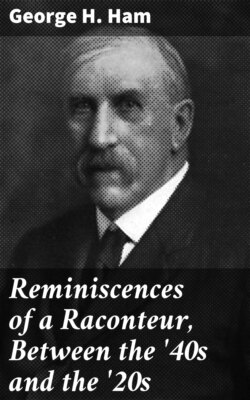Читать книгу Reminiscences of a Raconteur, Between the '40s and the '20s - George H. Ham - Страница 28
На сайте Литреса книга снята с продажи.
The Pembina Branch
ОглавлениеTable of Contents
In the early days of December, 1878, the last spike of the Pembina Branch of the C.P.R., connecting St. Boniface and St. Vincent, Minnesota, where connection was made with the St. Paul & Pacific road to St. Paul, was driven. There were no palatial sleepers or high-toned parlor cars in those days on the road, and the primitive train consisted of several not very comfortable flat cars and a box car in which were some rude benches, a lot of straw carpeting, and a small wood-burning heater. It was called “Joe Upper’s private parlor car”. There were a great many of the first families of Winnipeg aboard, many of the excursionists being of the gentler sex. The ceremony of driving the last spike took place at Rosseau River. There was a dispute as to which lady should have the honor of doing the driving, and to settle the controversy, U. S. Consul Taylor diplomatically suggested that they all take a whack at it. And they did—gently tapping the spike with a heavy sledge hammer, but not driving it very far into the tie. After all had had their turn, and the spike was still in painful evidence, the consul called upon Mary Sullivan, the big strong buxom daughter of the boss section man, who with one mighty blow drove the spike home amidst the loud cheers of the assembled multitude.
Jack McGinn, now with the Canada Carbide Company, of Shawinigan Falls, Que., was the first paymaster of the road, which was the first completed link of the C.P.R. system, and its first connection with any other railway, and it gave Manitoba and the Northwest their first rail connection with the outside world. The contractors were Upper & Willis, Joe being a Kingston (Ont.) boy. Immediately after, a primitive passenger service was inaugurated. On the first train, on which was a first-class car borrowed from the St. P. & P., were half a dozen or so passengers, and the conductor asked Jack for instructions as to their tickets, of which there weren’t any. Jack was equal to the emergency and wrote on an ordinary sheet of foolscap paper:
Ticket, No. 1, Trip No. 1, St. Boniface to St. Vincent. Passenger—S. Orson Shorey, December 2, 1878. J. St. L. McGinn.
To add to its value as a souvenir, Jack had it pretty well covered, front and back, with signatures, including: Frederick Hayward, conductor; J. Vannaman, driver; R. R. McLennan, road master; R. S. McGinn, master of stores. Big Rory McLennan was afterwards member of Parliament for Cornwall in the House of Commons, and the world’s champion for tossing the caber and throwing the hammer.
The following summer the Pembina Branch was taken over by the Government and was operated by T. J. Lynskey in charge until it passed into the hands of the present Canadian Pacific Railway Company. Mr. Shorey was very proud of his souvenir ticket which he kept carefully framed. Jack McGinn was not only paymaster, but the first superintendent of the C.P.R., then under the control of the contractor.
